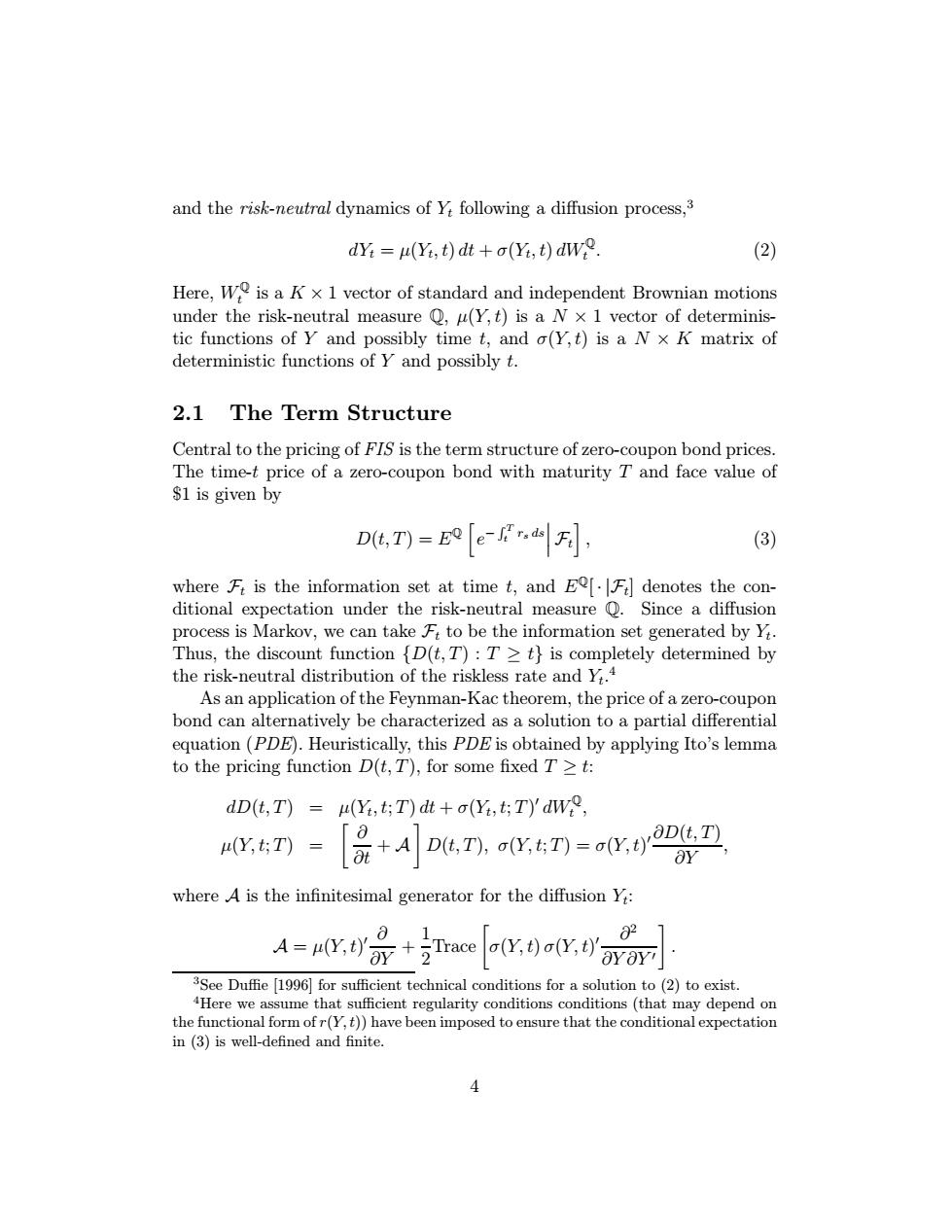正在加载图片...

and the risk-neutral dynamics of Y:following a diffusion process,3 dYi=u(Yi,t)dt+a(Yi,t)dw (2) Here,We is a Kx 1 vector of standard and independent Brownian motions under the risk-neutral measure Q,u(Y,t)is a N x 1 vector of determinis- tic functions of Y and possibly time t,and o(Y,t)is a N x K matrix of deterministic functions of Y and possibly t. 2.1 The Term Structure Central to the pricing of FIS is the term structure of zero-coupon bond prices. The time-t price of a zero-coupon bond with maturity T and face value of $1 is given by D(t,T)e (3) where F is the information set at time t,and EF denotes the con- ditional expectation under the risk-neutral measure Q.Since a diffusion process is Markov,we can take F to be the information set generated by Yi. Thus,the discount function [D(t,T):T>t}is completely determined by the risk-neutral distribution of the riskless rate and Yi.4 As an application of the Feynman-Kac theorem,the price of a zero-coupon bond can alternatively be characterized as a solution to a partial differential equation(PDE).Heuristically,this PDE is obtained by applying Ito's lemma to the pricing function D(t,T),for some fixed T>t: dD(t,T)=u(Yi,t;T)dt+a(Yi,t;T)'dw, (Y,t;T)= 成+4 D传,T),KT)=taD卫 where A is the infinitesimal generator for the diffusion Y: A=4品+ ay+Trace (Y,)σ(Y,元 2 YOY 3See Duffie [1996]for sufficient technical conditions for a solution to(2)to exist. 4Here we assume that sufficient regularity conditions conditions(that may depend on the functional form ofr(Y,t))have been imposed to ensure that the conditional expectation in (3)is well-defined and finite.and the risk-neutral dynamics of Yt following a diffusion process,3 dYt = µ(Yt, t) dt + σ(Yt, t) dWQ t . (2) Here, WQ t is a K × 1 vector of standard and independent Brownian motions under the risk-neutral measure Q, µ(Y, t) is a N × 1 vector of deterministic functions of Y and possibly time t, and σ(Y, t) is a N × K matrix of deterministic functions of Y and possibly t. 2.1 The Term Structure Central to the pricing of FIS is the term structure of zero-coupon bond prices. The time-t price of a zero-coupon bond with maturity T and face value of $1 is given by D(t, T) = EQ h e− R T t rs ds
Ft i , (3) where Ft is the information set at time t, and EQ[ · |Ft] denotes the conditional expectation under the risk-neutral measure Q. Since a diffusion process is Markov, we can take Ft to be the information set generated by Yt. Thus, the discount function {D(t, T) : T ≥ t} is completely determined by the risk-neutral distribution of the riskless rate and Yt. 4 As an application of the Feynman-Kac theorem, the price of a zero-coupon bond can alternatively be characterized as a solution to a partial differential equation (PDE). Heuristically, this PDE is obtained by applying Ito’s lemma to the pricing function D(t, T), for some fixed T ≥ t: dD(t, T) = µ(Yt, t; T) dt + σ(Yt, t; T) 0 dWQ t , µ(Y, t; T) = ∂ ∂t + A D(t, T), σ(Y, t; T) = σ(Y, t) 0 ∂D(t, T) ∂Y , where A is the infinitesimal generator for the diffusion Yt: A = µ(Y, t) 0 ∂ ∂Y + 1 2 Trace σ(Y, t) σ(Y, t) 0 ∂2 ∂Y ∂Y 0 . 3See Duffie [1996] for sufficient technical conditions for a solution to (2) to exist. 4Here we assume that sufficient regularity conditions conditions (that may depend on the functional form of r(Y, t)) have been imposed to ensure that the conditional expectation in (3) is well-defined and finite. 4